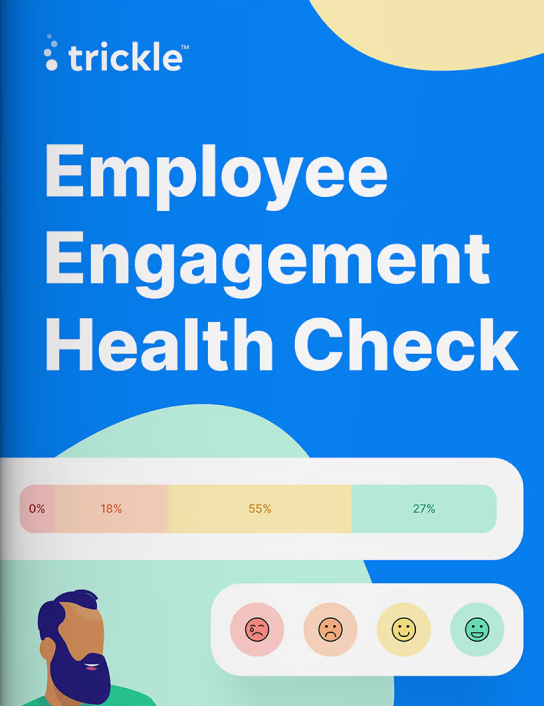How well does your company engage its employees?
Take your health check and find out.


If you want to improve your workplace culture so that having difficult conversations at work is a healthier process for your organisation, then our latest article will offer some expert guidance for you.
As part of the HR team within your business, you’re one of the main people your employees will turn to when they have an issue.
According to the Chartered Management Institute (CMI), the top three difficult conversations are about pay (33%), inappropriate behaviour (31%) and feedback on poor performance (30%).
While it may not be the most pleasant aspect of your role, learning how to have difficult conversations at work is one of the most important things you can do to support the people within your organisation.
Issues highlighted by an employee generally form around a need to discuss sensitive personal matters. For example, health or death in the family. They may also want HR to investigate instances of bullying or inappropriate behaviour.
When wider problems stem from issues related to employees, managers may ask HR teams to help them address poor performance or discuss an employee’s potential risk of redundancy.
Continue reading to learn more about the most common types of difficult conversations and how to navigate them with empathy and ease.
Difficult conversations at work can be about any of the following:
Before starting difficult conversations, allocate a couple of minutes for yourself. Taking some deep breaths and finding calmness will help you collect your thoughts and approach issues from a more centred starting point.
Now it’s time to tackle the issues at hand…
Delivering news about redundancies is never easy, but the workplace will be improved as a whole when dealt with in the right way.
Here are five tips for how to talk to employees about redundancies.
Performance-related problems often come knocking on HR’s door. Initial key steps to addressing poor performance include:
Also try to see poor performance as an opportunity to better your processes. Framing your discussions in a more positive light will help to bring positive energy to the conversation.
Never go in with an “I know better” mindset. Instead, think:
Managing employee behaviour is key to ensuring your workplace is safe, welcoming and uplifting for everyone. Examples of everyday misconduct are:
Resolving misconduct promptly is essential for protecting employees, promoting teamwork and upholding best practices. Discussing misconduct with an employee can be very difficult, though.
A lot of conflict can be rectified through training or one-on-one discussions. Reactions to criticism can be defensive when pride is involved, so focus on clear communication.
Some simple ways you can solve issues of misconduct are:
Privacy and anonymity is key when it comes to negative colleague relationships. HR’s job is to make sure every employee feels safe, so it can be difficult to be pragmatic when dealing with obvious prejudice or bullying in the workplace.
When having difficult conversations around mistreatment of others, it’s important to lift yourself from the situation, look at it from an outside perspective and listen openly to both sides of the argument.
Addressing mistreatment between colleagues seriously and quickly shows that you trust your employees — you hear what they have to say and value their happiness.
Jot down some notes and key points and ask others for their advice before you have your conversation — especially if it’s a particularly difficult one.
Try to see every conversation as an opportunity to be constructive, to collaborate and find solutions together.
Remember — you’re not meant to have all the answers. As an HR team member, you’re not just there to deliver news or solve heated situations, you’re also there to ensure everyone’s voice is heard and valued.
Working together to reach a satisfactory conclusion wherever possible means approaching people with simple, clear and neutral processes.
Be considerate and compassionate. Actively listening and acknowledging the issues that an employee is having is the first step toward navigating difficult conversations in a professional and purposeful manner. You don’t necessarily have to agree with their view, but you should make them feel heard.
Use “and” instead of “but” to show that you value the employee’s perspective and that you are accepting of their situation.
Be open-minded and flexible in your approach to reach a resolution that ensures everyone feels they found a reasonable solution.
While the goal of HR is to ensure everyone’s voice is heard and valued — and that positive change is implemented — there won’t always be a straightforward solution.
When that happens, transparency is key. Explain what the barriers are to resolving the issue to help everyone understand the constraints you have.
Always ensure that once the conversation is finished, it is left inside that meeting room. Acknowledge what’s been discussed, what’s been agreed and how you can move it forward together.
Consider what went well, and what didn’t. Did the conversation remain focused and productive? Did you stick to the facts of the situation? Did you follow your company’s processes?
Every productive conversation will help you manage more difficult ones in the future. No one likes being disciplined, but when delivered in the right way, it can make employees happier in the long run.
Ultimately, you want to motivate and uplift your staff — empathy goes a long way in helping resolve issues. Inclusivity and collaboration through Trickle makes tackling difficult conversations a lot easier.
Speaking up isn’t always easy. Trickle’s Flare feature allows employees to reach out anonymously, meaning they can flag if team members are making them feel uncomfortable or if they see others being mistreated.
Trickle’s MoodSense feature lets you gauge employee feelings in real-time, helping you identify where grievances lie so that you can jump on issues before they become a difficult conversation.
In the Champions Chat area, colleagues can collaborate and discuss issues and work together to innovate and make improvements.
In the unlikely scenario of dealing with unacceptable or abusive posts, Trickle provides 3 “safety net” features that you can use:
After difficult conversations, it’s worthwhile reflecting with other Champions in your team to consider what went well and what didn’t. You can see feedback on how others may have managed similar situations to help improve your experience as a Trickle Champion.